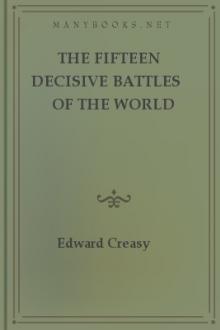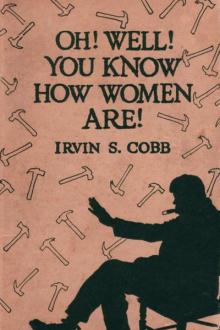Falling in Love by Grant Allen (different e readers .txt) 📕

- Author: Grant Allen
- Performer: -
Book online «Falling in Love by Grant Allen (different e readers .txt) 📕». Author Grant Allen
In fact, I think there can be but little doubt that the banana is the very oldest product of human tillage. Man, we must remember, is essentially by origin a tropical animal, and wild tropical fruits must necessarily have formed his earliest food-stuffs. It was among them of course that his first experiments in primitive agriculture would be tried; the little insignificant seeds and berries of cold northern regions would only very slowly be added to his limited stock in husbandry, as circumstances pushed some few outlying colonies northward and ever northward toward the chillier unoccupied regions. Now, of all tropical fruits, the banana is certainly the one that best repays cultivation. It has been calculated that the same area which will produce thirty-three pounds of wheat or ninety-nine pounds of potatoes will produce 4,400 pounds of plantains or bananas. The cultivation of the various varieties in India, China, and the Malay Archipelago dates, says De Candolle, 'from an epoch impossible to realise.' Its diffusion, as that great but very oracular authority remarks, may go back to a period 'contemporary with or even anterior to that of the human races.' What this remarkably illogical sentence may mean I am at a loss to comprehend; perhaps M. de Candolle supposes that the banana was originally cultivated by pre-human gorillas; perhaps he merely intends to say that before men began to separate they sent special messengers on in front of them to diffuse the banana in the different countries they were about to visit. Even legend retains some trace of the extreme antiquity of the species as a cultivated fruit, for Adam and Eve are said to have reclined under the shadow of its branches, whence Linnæus gave to the sort known as the plantain the Latin name of Musa paradisiaca. If a plant was cultivated in Eden by the grand old gardener and his wife, as Lord Tennyson democratically styled them (before his elevation to the peerage), we may fairly conclude that it possesses a very respectable antiquity indeed.
The wild banana is a native of the Malay region, according to De Candolle, who has produced by far the most learned and unreadable work on the origin of domestic plants ever yet written. (Please don't give me undue credit for having heroically read it through out of pure love of science: I was one of its unfortunate reviewers.) The wild form produces seed, and grows in Cochin China, the Philippines, Ceylon, and Khasia. Like most other large tropical fruits, it no doubt owes its original development to the selective action of monkeys, hornbills, parrots and other big fruit-eaters; and it shares with all fruits of similar origin one curious tropical peculiarity. Most northern berries, like the strawberry, the raspberry, the currant, and the blackberry, developed by the selective action of small northern birds, can be popped at once into the mouth and eaten whole; they have no tough outer rind or defensive covering of any sort. But big tropical fruits, which lay themselves out for the service of large birds or monkeys, have always hard outer coats, because they could only be injured by smaller animals, who would eat the pulp without helping in the dispersion of the useful seeds, the one object really held in view by the mother plant. Often, as in the case of the orange, the rind even contains a bitter, nauseous, or pungent juice, while at times, as in the pine-apple, the prickly pear, the sweet-sop, and the cherimoyer, the entire fruit is covered with sharp projections, stinging hairs, or knobby protuberances, on purpose to warn off the unauthorised depredator. It was this line of defence that gave the banana in the first instance its thick yellow skin; and, looking at the matter from the epicure's point of view, one may say roughly that all tropical fruits have to be skinned before they can be eaten. They are all adapted for being cut up with a knife and fork, or dug out with a spoon, on a civilised dessert-plate. As for that most delicious of Indian fruits, the mango, it has been well said that the only proper way to eat it is over a tub of water, with a couple of towels hanging gracefully across the side.
The varieties of the banana are infinite in number, and, as in most other plants of ancient cultivation, they shade off into one another by infinitesimal gradations. Two principal sorts, however, are commonly recognised—the true banana of commerce, and the common plantain. The banana proper is eaten raw, as a fruit, and is allowed accordingly to ripen thoroughly before being picked for market; the plantain, which is the true food-stuff of all the equatorial region in both hemispheres, is gathered green and roasted as a vegetable, or, to use the more expressive West Indian negro phrase, as a bread-kind. Millions of human beings in Asia, Africa, America, and the islands of the Pacific Ocean live almost entirely on the mild and succulent but tasteless plantain. Some people like the fruit; to me personally it is more suggestive of a very flavourless over-ripe pear than of anything else in heaven or earth or the waters that are under the earth—the latter being the most probable place to look for it, as its taste and substance are decidedly watery. Baked dry in the green state 'it resembles roasted chestnuts,' or rather baked parsnip; pulped and boiled with water it makes 'a very agreeable sweet soup,' almost as nice as peasoup with brown sugar in it; and cut into slices, sweetened, and fried, it forms 'an excellent substitute for fruit pudding,' having a flavour much like that of potatoes à la maítre d'hótel served up in treacle.
Altogether a fruit to be sedulously avoided, the plantain, though millions of our spiritually destitute African brethren haven't yet for a moment discovered that it isn't every bit as good as wheaten bread and fresh butter. Missionary enterprise will no doubt before long enlighten them on this subject, and create a good market in time for American flour and Manchester piece-goods.
Though by origin a Malayan plant, there can be little doubt that the banana had already reached the mainland of America and the West India Islands long before the voyage of Columbus. When Pizarro disembarked upon the coast of Peru on his desolating expedition, the mild-eyed, melancholy, doomed Peruvians flocked down to the shore and offered him bananas in a lordly dish. Beds composed of banana leaves have been discovered in the tombs of the Incas, of date anterior, of course, to the Spanish conquest. How did they get there? Well, it is clearly an absurd mistake to suppose that Columbus discovered America; as Artemus Ward pertinently remarked, the noble Red Indian had obviously discovered it long before him. There had been intercourse of old, too, between Asia and the Western Continent; the elephant-headed god of Mexico, the debased traces of Buddhism in the Aztec religion, the singular coincidences between India and Peru, all seem to show that a stream of communication, however faint, once existed between the Asiatic and American worlds. Garcilaso himself, the half-Indian historian of Peru, says that the banana was well known in his native country before the conquest, and that the Indians say 'its origin is Ethiopia.' In some strange way or other, then, long before Columbus set foot upon the low sandbank of Cat's Island, the banana had been transported from Africa or India to the Western hemisphere.
If it were a plant propagated by seed, one would suppose that it was carried across by wind or waves, wafted on the feet of birds, or accidentally introduced in the crannies of drift timber. So the coco-nut made the tour of the world ages before either of the famous Cooks—the Captain or the excursion agent—had rendered the same feat easy and practicable; and so, too, a number of American plants have fixed their home in the tarns of the Hebrides or among the lonely bogs of Western Galway. But the banana must have been carried by man, because it is unknown in the wild state in the Western Continent; and, as it is practically seedless, it can only have been transported entire, in the form of a root or sucker. An exactly similar proof of ancient intercourse between the two worlds is afforded us by the sweet potato, a plant of undoubted American origin, which was nevertheless naturalised in China as early as the first centuries of the Christian era. Now that we all know how the Scandinavians of the eleventh century went to Massachusetts, which they called Vineland, and how the Mexican empire had some knowledge of Accadian astronomy, people are beginning to discover that Columbus himself was after all an egregious humbug.
In the old world the cultivation of the banana and the plantain goes back, no doubt, to a most immemorial antiquity. Our Aryan ancestor himself, Professor Max Müller's especial protégé, had already invented several names for it, which duly survive in very classical Sanskrit. The Greeks of Alexander's expedition saw it in India, where 'sages reposed beneath its shade and ate of its fruit, whence the botanical name, Musa sapientum.' As the sages in question were lazy Brahmans, always celebrated for their immense capacity for doing nothing, the report, as quoted by Pliny, is no doubt an accurate one. But the accepted derivation of the word Musa from an Arabic original seems to me highly uncertain; for Linnæus, who first bestowed it on the genus, called several other allied genera by such cognate names as Urania and Heliconia. If, therefore, the father of botany knew that his own word was originally Arabic, we cannot acquit him of the high crime and misdemeanour of deliberate punning. Should the Royal Society get wind of this, something serious would doubtless happen; for it is well known that the possession of a sense of humour is absolutely fatal to the pretensions of a man of science.
Besides its main use as an article of food, the banana serves incidentally to supply a valuable fibre, obtained from the stem, and employed for weaving into textile fabrics and making paper. Several kinds of the plantain tribe are cultivated for this purpose exclusively, the best known among them being the so-called manilla hemp, a plant largely grown in the Philippine Islands. Many of the finest Indian shawls are woven from banana stems, and much of the rope that we use in our houses comes from the same singular origin. I know nothing more strikingly illustrative of the extreme complexity of our modern civilisation than the way in which we thus every day employ articles of exotic manufacture in our ordinary life without ever for a moment suspecting or inquiring into their true nature. What lady knows when she puts on her delicate wrapper, from Liberty's or from Swan and Edgar's, that the material from which it is woven is a Malayan plantain stalk? Who ever thinks that the glycerine for our chapped hands comes from Travancore coco-nuts, and that the pure butter supplied us from the farm in the country is





Comments (0)